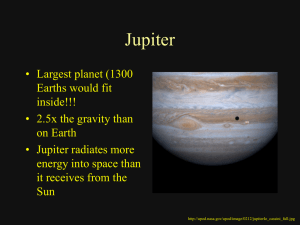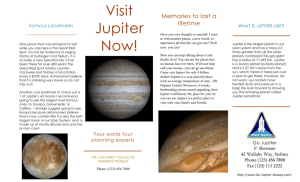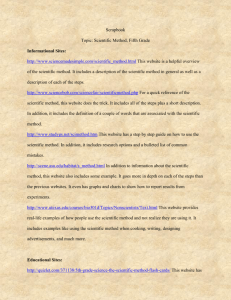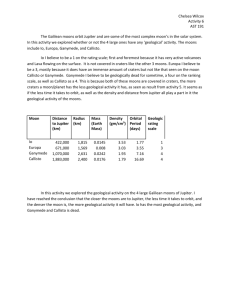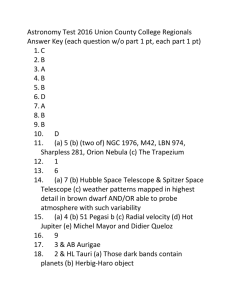The Galilean Moons - d_smith.lhseducators.com
advertisement
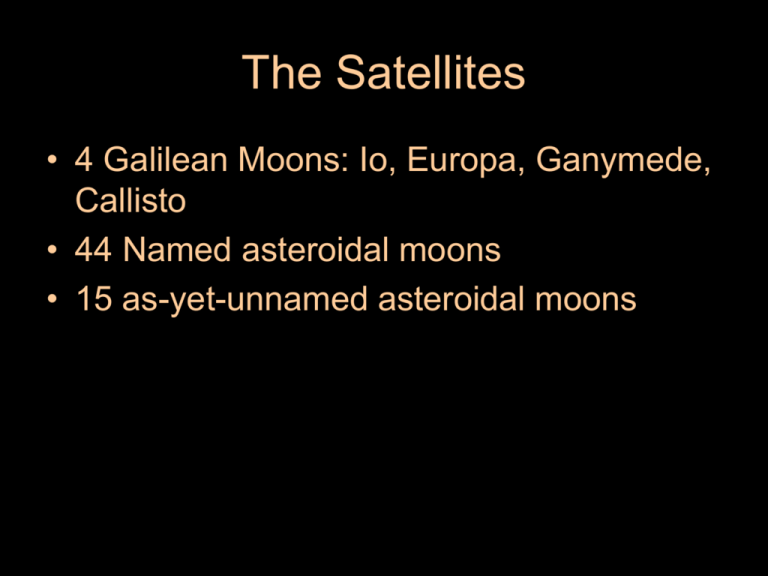
The Satellites • 4 Galilean Moons: Io, Europa, Ganymede, Callisto • 44 Named asteroidal moons • 15 as-yet-unnamed asteroidal moons The orbits of the moons are in resonance with one another. All 4 moons orbit in synchronous rotation. Moon Data Radius (km) Io 1821 Europa 1561 Ganymede 2631 Callisto 2410 Density 3530 (kg/m3) 3010 1940 1830 Orbit Radius (Rj) 9.4 15.0 26.3 5.9 Io • More than 80 erupting volcanoes. • Surface is entirely sulfur and sulfur compounds. • Volcanoes spew sulfur dioxide, which “rains” back onto the surface. – Electrically conductive sulfur and oxygen ions escape Io’s gravity, and orbit Jupiter in a torus. Tvashtar Eruption Movie • Planetary Society The Io Plasma Torus rotates along with Jupiter’s magnetic field, once every 10 hours. Jupiter’s magnetic field is not aligned perfectly with its spin axis, so the torus has a “wobble”. A movie of the Io Plasma Torus http://haydenplanetarium.org/resources/ava/page/index.php?file=P0404juptorus An electrical current flows from Jupiter to Io and back again: 2 trillion watts of power. This current flows through the Flux Tube. When Io is properly aligned, this current emits radio signals at around 20.1 MHz. (Radio Jove Project) Why hasn’t Io cooled off? • Io is about the same size and mass as the earth’s moon. • Our moon shows no current volcanic activity. • Why isn’t Io in the same state? Europa • Salty ice crust – the flattest surface of any planet or moon in the solar system • Subsurface liquid or slushy ocean? • Linea or tectonic cracks • Few craters Minos Linea Region Ganymede • The largest moon in the solar system – larger than Mercury and Pluto • Icy crust – Older, heavily-cratered dark regions. – Younger, lighter-colored terrain, where liquid water has erupted from beneath the surface. Ganymede’s Interior • Mottled, grooved surface • Evidence that subsurface water has erupted onto the surface • A metallic core with an icy mantle is implied. • (Rocky outcrops under the ice) Callisto • Heavily cratered icy surface indicates that the surface is original, not changed by tectonic processes. • This implies that Callisto may have no core, or may be incompletely differentiated (layered). Palimpsests • Palimpsest (ghost craters) – ice rebounds slowly after impact – crater is filled back to original surface elevation – leaves behind only a crater “fingerprint” – Name comes from a re-used writing parchment. The Valhalla palimpsest – as big as the U.S. Palimpsest – a parchment partly erased and reused. The former ghostly writing shows through underneath. Only 6 Missions • Pioneer 10 – launched early 1972, flyby Dec., 1973. – first mission to pass through the asteroid belt. – first mission to photograph Jupiter, just 130,000 km above cloud tops. – last signal received 2003 • Pioneer 11 – launched 1973, flyby 1979 – took photos of Jupiter & Great Red Spot Voyager • Voyager 1 – 1977, flyby 1980 – studied and photographed Jupiter’s moons – currently the most distant man-made spacecraft, 100 A.U. • Voyager 2 – 1977, flyby 1981 – studied and photographed GRS and Io’s volcanism Galileo • Launched 1989 • Problems with main antenna, computers • Made 34 orbits through Jovian system • Sent a probe into Jupiter’s upper atmosphere • Purposely crashed into Jupiter in 2003 so it wouldn’t accidentally crash into Europa and possibly contaminate that moon Galileo science highlights • Enormous thunderstorms within Jupiter’s upper atmosphere • Studied Io’s volcanism • Found even stronger evidence for Europa’s subsurface ocean • Found that Ganymede has its own magnetic field • Callisto may also have a subsurface ocean and a magnetic field Cassini • Primarily a mission to Saturn. • Made a flyby of Jupiter on Dec. 30, 2000 (the Millenium Flyby) • Unusual that two U.S. spacecraft on independent missions were observing another planet at the same time. http://nssdc.gsfc.nasa.gov/planetary/factsheet/jupiterfact.html http://www.blue-cosmos.de/system/jupiter.html http://www.pa.msu.edu/people/horvatin/Images/Planets/jupiter/ http://en.wikipedia.org/wiki/Image:OblateSpheroid.PNG http://www.jpl.nasa.gov/images/sim/jupiter-earth-browse.jpg http://www.enchantedlearning.com/jgifs/Jupiterearthsun.GIF http://www.windows.ucar.edu/jupiter/images/jupiter_magneto_small.jpg http://physics.uoregon.edu/~jimbrau/BrauImNew/Chap11/FG11_13.jpg http://ase.tufts.edu/cosmos/pictures/Explore_figs_5/Chapter3/Fig3_16.jpg http://www.astrophysicsspectator.com/topics/planets/JupiterMagnetosphere.html http://www.space.com/scienceastronomy/solarsystem/jupiter_elements_991117.html http://antwrp.gsfc.nasa.gov/apod/image/0311/jupiterp_cassini_full.jpg http://quest.nasa.gov/galileo/features/data.html http://www2.jpl.nasa.gov/galileo/graphics/230-1226B_s.gif http://physics.uoregon.edu/~jimbrau/BrauImNew/Chap11/FG11_10.jpg http://astro.gmu.edu/classes/a10594/notes/l20/l20.html http://www.astro.lsa.umich.edu/~haller/ast_160/copy/jupiter_rot.jpg http://www.windows.ucar.edu/jupiter/images/belts_zones_disc.gif http://sse.jpl.nasa.gov/multimedia/gallery/PIA00014.jpg http://www.universetoday.com/category/jupiter/ http://www.windows.ucar.edu/jupiter/images/J_moon_orbits.gif http://www.mysciencesite.com/sse_moon_sizes.jpg http://www.pa.msu.edu/people/horvatin/Images/Planets/jupiter/Io.jpg http://www.unet.univie.ac.at/~a9503672/astro/grafiken/solar/volcano-on-io.jpg http://vega.lpl.arizona.edu/iotorus/iotorus-frame.html http://csep10.phys.utk.edu/astr161/lect/jovian_moons/promdisk.jpg http://ufro1.astro.ufl.edu/iotorus.jpg http://www.planetaryexploration.net/jupiter/io/images/jupiter_aurora_01257.jpg http://hal.physast.uga.edu/~jss/1010/ch11/ http://www2.jpl.nasa.gov/galileo/mess41/images/min_lineargn.gif http://antwrp.gsfc.nasa.gov/apod/image/9903/ganymede_galmosaic_big.jpg http://slamdunk.geol.ucl.ac.uk/~brodholt/B165/Figures/Planets/chaos_europa.jpg http://www.astr.ua.edu/ay102/Lab5/Jupiter/callisto.jpg http://planetscapes.com/art/browse/calint.jpg http://www.oulu.fi/astronomy/planetology/TerrPlanets/Pl1_2001/T_Suokas/valhalla.gif http://www.dexus-hosting.cz/o-dexus/pojmenovani-serveru/_img/callisto/valhalla.jpg http://www2.jpl.nasa.gov/galileo/graphics/rings.gif http://www.news.cornell.edu/releases/sept98/rings/300/jupmos.GIF http://www.windows.ucar.edu/tour/link=/jupiter/space_missions.html http://quest.nasa.gov/sso/cool/pioneer10/graphics/lasher/slide2lg.gif http://voyager.jpl.nasa.gov/ http://galileo.jpl.nasa.gov/discovery.cfm http://solarsystem.nasa.gov/multimedia/gallery/galileo.jpg http://solarsystem.nasa.gov/multimedia/gallery/Galileo_Diagram.jpg http://www.spacetoday.org/SolSys/Jupiter/JupiterCassini.html

